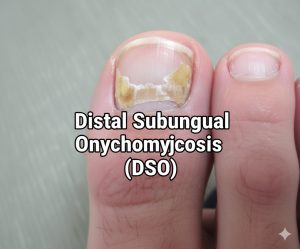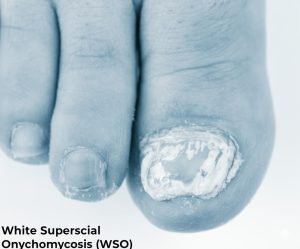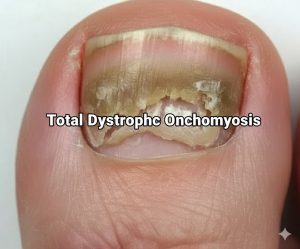What Does Toenail Fungus Look Like: Toenail fungus, additionally known as onychomycosis, is a commonplace but frequently misunderstood situation. It can affect absolutely everyone, but certain factors growth the threat of growing this ugly and every now and then painful condition. At the Foot and Ankle Center of Arizona, led by Dr. Kris A. DiNucci, DPM, FACFAS, we goal to offer complete care and training that will help you recognize, deal with, and prevent toenail fungus. In this newsletter, we will explore what toenail fungus seems like, the symptoms, reasons, and to be had treatments.
Type of Toenail Fungus
Toenail fungus, medically known as onychomycosis, can appear in several forms depending on the type of fungus causing the infection. Understanding these types can help you recognize the symptoms early and seek proper treatment.
1. Distal Subungual Onychomycosis (DSO)
This is the most common type of toenail fungus. It usually starts at the tip of the nail and spreads underneath. Signs include:
- Yellow or white discoloration at the nail tip
- Thickened or brittle nails
- Crumbling edges
2. White Superficial Onychomycosis (WSO)
This type affects the surface of the nail rather than growing under it. Symptoms include:
- White patches on the top layer of the nail
- Nail becomes soft and powdery
- Often easier to treat than other types
3. Proximal Subungual Onychomycosis (PSO)
A less common form that often affects people with weakened immune systems. Signs include:
- White spots near the base of the nail
- Gradual spreading towards the tip
- Possible pain or tenderness
4. Candida Onychomycosis
Caused by yeast infections rather than the typical dermatophytes. Symptoms include:
- Redness around the nail
- Swelling and tenderness
- Nails may separate from the nail bed
5. Total Dystrophic Onychomycosis
This is the most severe form and usually develops after long-term untreated infections. Characteristics include:
- Thick, brittle, and discolored nails
- Complete destruction of the nail structure
- Often requires professional medical treatment
What Does Toenail Fungus Look Like?
Toenail fungus can appear in numerous methods, depending at the severity and kind of fungal infection. Here are a few not-unusual visual signs:
- Discoloration: One of the earliest and most noticeable signs of toenail fungus is discoloration. The affected nail may turn white, yellow, brown, or even black. This discoloration often starts at the tip of the nail and gradually spreads towards the base.
- Thickened Nails: As the infection progresses, the toenail often becomes thicker and more difficult to trim. The thickened nail can cause discomfort, especially when wearing shoes.
- Brittle or Crumbly Nails: Infected toenails may become brittle and start to crumble or break easily. This fragility is a result of the fungal infection weakening the nail structure.
- Distorted Nail Shape: The shape of the nail may change, becoming warped or irregular. This distortion can affect the appearance and function of the nail.
- Separation from the Nail Bed: In more severe cases, the toenail may separate from the nail bed, a condition known as onycholysis. This can cause pain and create a gap that may become infected with bacteria.
- Foul Odor: A foul smell may emanate from the infected nail due to the accumulation of fungal debris under the nail.
Symptoms Beyond Appearance
While the visual signs are significant, other symptoms can accompany toenail fungus:
Pain and Discomfort: Infected toenails can cause pain, especially when pressure is applied, such as while walking or wearing tight shoes.
Itching and Burning: The area around the infected nail may become itchy or have a burning sensation.
Swelling: The skin around the toenail can become red and swollen, particularly if there is a secondary bacterial infection.
Causes of Toenail Fungus
Toenail fungus results from numerous styles of fungi, along with dermatophytes, yeasts, and molds. These fungi thrive in heat, moist environments, making positive conditions conducive to their increase. Common causes and hazard elements consist of:
- Public Areas: Walking barefoot in public places like swimming pools, locker rooms, and showers can increase the risk of fungal infections.
- Nail Trauma: Injury to the nail can create an entry point for fungi.
- Poor Foot Hygiene: Not keeping feet clean and dry can create a suitable environment for fungal growth.
- Sweaty Feet: Excessive sweating can keep the feet moist, promoting fungal infections.
- Footwear: Wearing tight, non-breathable shoes can trap moisture around the toes.
- Medical Conditions: People with diabetes, weakened immune systems, or circulatory issues are more susceptible to fungal infections.
- Age: Older adults are at higher risk due to reduced blood circulation and slower nail growth.
Diagnosis
Diagnosing toenail fungus involves a combination of visual examination and laboratory tests. Dr. Kris A. DiNucci, DPM, FACFAS, at the Foot and Ankle Center of Arizona, typically starts with a thorough examination of the affected nails. If necessary, a sample of the nail or skin debris can be taken and analyzed under a microscope or cultured to identify the specific type of fungus.
Treatment Options
Treating toenail fungus can be challenging and often requires a combination of approaches. Here are some common treatments:
- Topical Antifungal Medications: These are applied directly to the nail and surrounding skin. They are most effective in mild to moderate cases but may not penetrate thickened nails well.
- Oral Antifungal Medications: Oral medications can be more effective as they treat the infection from within. Commonly prescribed drugs include terbinafine and itraconazole. However, they may have facet results and require tracking through a healthcare provider.
- Laser Treatment: Laser therapy is a newer treatment option that uses focused light to destroy the fungus. It is considered safe and can be effective, but it might require multiple sessions.
- Nail Removal: In severe cases, removing the infected nail may be necessary to allow for direct treatment of the nail bed and to facilitate the growth of a healthy nail.
- Home Remedies: Some patients try home remedies like tea tree oil, vinegar soaks, or over-the-counter antifungal creams. While these may provide relief for some, their effectiveness is generally not as high as prescription treatments.
Prevention
Preventing toenail fungus is crucial to avoid recurrence and maintain healthy nails. Here are some tips:
- Good Foot Hygiene: Wash your feet daily with soap and water, and dry them thoroughly, especially between the toes.
- Keep Nails Trimmed: Regularly trim your nails straight across and file down thickened areas.
- Wear Breathable Footwear: Choose shoes made of materials that allow your feet to breathe and avoid tight-fitting shoes.
- Change Socks Regularly: Wear clean, dry socks and change them if they become damp.
- Use Antifungal Sprays or Powders: These can help keep your feet dry and prevent fungal growth.
- Avoid Walking Barefoot in Public Areas: Always wear sandals or shower shoes in public pools, locker rooms, and showers.
- Disinfect Nail Tools: Regularly clean and disinfect nail clippers, files, and other tools.
- Do Not Share Personal Items: Avoid sharing shoes, socks, or nail care tools with others.
Conclusion
Recognizing the signs of toenail fungus early can help prevent the condition from worsening and spreading. At the Foot and Ankle Center of Arizona, Dr. Kris A. DiNucci and our team are dedicated to providing comprehensive care for all your foot and ankle health needs. If you suspect you have toenail fungus or have any concerns about your foot health, don’t hesitate to contact us for a consultation. Together, we can increase a personalized treatment plan to repair the fitness and look of your nails.
Understanding what toenail fungus looks like, its causes and the available treatments empowers you to take control of your foot health. By following preventive measures and searching for professional care whilst needed, you can keep your toes healthful and free from fungal infections.









